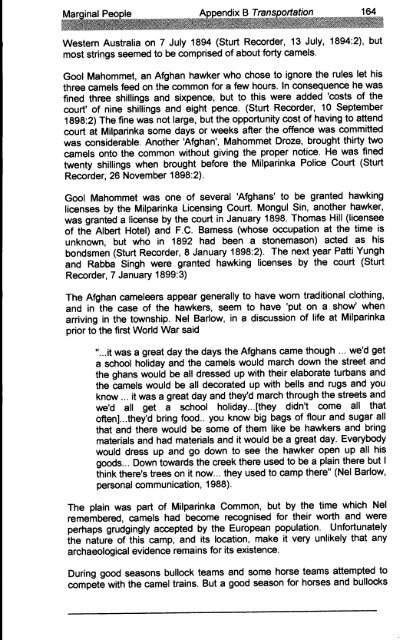Adec Preview Generated PDF File - The Sydney eScholarship ...
Adec Preview Generated PDF File - The Sydney eScholarship ...
Adec Preview Generated PDF File - The Sydney eScholarship ...
You also want an ePaper? Increase the reach of your titles
YUMPU automatically turns print PDFs into web optimized ePapers that Google loves.
Western Australia on 7 July 1894 (Sturt Recorder, 13 July, 1894:2), but<br />
most strings seemed to be comprised of about forty camels.<br />
Gool Mahommet, an Afghan hawker who chose to ignore the rules let his<br />
three camels feed on the common for a few hours. In consequence he was<br />
fined three shillings and sixpence, but to this were added 'costs of the<br />
court' of nine shillings and eight pence. (Sturt Recorder, 10 September<br />
1898:2) <strong>The</strong> fine was not large, but the opportunity cost of having to attend<br />
court at Milparinka some days or weeks after the offence was committed<br />
was considerable. Another 'Afghan', Mahommet Croze, brought thirty two<br />
camels onto the common without giving the proper notice. He was fined<br />
twenty shillings when brought before the Milparinka Police Court (Sturt<br />
Recorder, 26 November 1898:2).<br />
Gool Mahommet was one of several 'Afghans' to be granted hawking<br />
licenses by the Milparinka Licensing Court. Mongul Sin, another hawker,<br />
was granted a license by the court in January 1898. Thomas Hill (licensee<br />
of the Albert Hotel) and F.C. Bamess (whose occupation at the time is<br />
unknown, but who in 1892 had been a stonemason) acted as his<br />
bondsmen (Sturt Recorder, 8 January 1898:2). <strong>The</strong> next year Patti Yungh<br />
and Rabba Singh were granted hawking licenses by the court (Sturt<br />
Recorder, 7 January 1899:3)<br />
<strong>The</strong> Afghan cameleers appear generally to have worn traditional clothing,<br />
and in the case of the haWkers, seem to have 'put on a show' when<br />
arriving in the township. Nel Barlow, in a discussion of life at Milparinka<br />
prior to the first World War said<br />
"... it was a great day the days the Afghans came though ... we'd get<br />
a school holiday and the camels would march down the street and<br />
the ghans would be all dressed up with their elaborate turbans and<br />
the camels would be all decorated up with bells and rugs and you<br />
know ... it was a great day and they'd march through the streets and<br />
we'd all get a school holiday...[they didn't come all that<br />
often]...they'd bring food .. you know big bags of flour and sugar all<br />
that and there would be some of them like be hawkers and bring<br />
materials and had materials and it would be a great day. Everybody<br />
would dress up and go down to see the hawker open up all his<br />
goods... Down towards the creek there used to be a plain there but I<br />
think there's trees on it now... they used to camp there" (Nel Barlow,<br />
personal communication, 1988).<br />
<strong>The</strong> plain was part of Milparinka Common, but by the time which Nel<br />
remembered, camels had become recognised for their worth and were<br />
perhaps grudgingly accepted by the European population. Unfortunately<br />
the nature of this camp, and its location, make it very unlikely that any<br />
archaeological evidence remains for its existence.<br />
During good seasons bullock teams and some horse teams attempted to<br />
compete with the camel trains. But a good season for horses and bullocks




